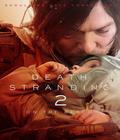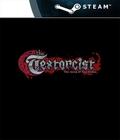Buy The Textorcist: The Story of Ray Bibbia
Typing is something that everyone does now that the computer has become almost ubiquitous in most households. Unless you're completely dependent on your phone or tablet and only have a PC as a makeshift console, you have typed often on a keyboard, no matter your actual typing proficiency. With that said, it's interesting how so few games try to make the act of typing fun. The Typing of the Dead makes you type in what is essentially a light gun game — minus the actual light gun. Epistory: Typing Chronicles makes the typing of words a weapon in a grand adventure game, while Hacknet is essentially a hacking simulator that's heavy on the simulation and light on flash. The Textorcist: The Story of Ray Bibbia is another game that tries to use typing to its fullest while mashing it up with something unexpected: a bullet-hell shooter.
In The Textorcist, it is almost the end of the 20th century, and the Church has complete political control over Rome. Things go well until the last Pope passes away, leaving the government without a leader and about to descend into chaos. You play the role of Ray Bibbia, a priest who has been excommunicated from the Church. In order to make ends meet, he takes on the job of a private investigator and exorcist. It's during one of these jobs that Ray gets entangled in something much bigger than he could have imagined.
The presentation is a bit far-fetched, but the story does a good job of riding the line between semi-serious and parody. The dialogue seems serious at times, but then you'll get an absurd line thrown in to break the mood. Ray is characterized as a typical disgruntled private eye, but he seems to be the sanest character, as everyone else either has absurd lines, abnormal character traits, or a mix of both. The objects are also "punny," with holy names given to his computer, journal and map. Taken as a whole, the story isn't too compelling or memorable, but you feel that some care was taken in an otherwise throwaway narrative.
As alluded to earlier, the inspiration for the core mechanics is the bullet-hell shooter. The enemies you face try their best to fill the screen with bullets, and they attack in patterns that'll be familiar to shooting game fans. Unlike most shooters, you don't face off against smaller minions before progressing to the boss in a level. Instead, the combat is comprised mainly of boss fights, which some would argue are the best parts of shooters anyway. The game is presented from a top-down perspective, so you have an ample amount of space to move around, with each fight taking place in decently sized rooms.
The one difference between The Textorcist and other bullet-hell shooters is that you have no way to save yourself with things like screen-clearing bombs. In fact, you only have one weapon in your arsenal: your Bible. You have the ability to shoot holy bullets from your Bible, but that can only be done by typing out the words from the verses you're reading. These aren't just a few words or parts of a sentence but complete lengthy lines. Completing each line allows you to deliver a barrage of bullets and stuns the enemy long enough to get a short cut scene before you continue the battle. The challenge comes from being able to type and move at the same time, as one hit knocks the Bible out of your hand and interrupts your lines. Take too long to retrieve the sacred book, and you'll have to restart the incantation from the beginning.
As expected, the combination of typing long sentences and having to dodge enemy projectiles is frantic and rather difficult. The enemy bullet patterns are on par with what you'd see in other bullet-hell shooters, and while they aren't as relentless, they're still enough to force you to be aware of your surroundings at all times. Your attack area is large but not large enough that you can hide in a corner and type away, forcing you to juggle both typing and moving. The default controls have you using your arrow keys for movement, which means either constantly repositioning yourself before stopping to get in a few keystrokes or having to learn to move with one hand and simultaneously type with another, a task akin to rubbing your belly and patting your head at the same time. On top of all this, the bosses make things more difficult by messing with the text at times. One boss, for example, may vomit on your lines, so you either have to memorize what you need to type or use blind luck to solve things, while other bosses make you have to read upside-down before taking on some damage.
The Textorcist isn't completely mean to you, though, as there are a few concessions to lessen the frustration. You have the option to hold down the Shift key in conjunction with the WASD keys for movement, something that some players find much more preferable since it means never having to leave the main body of keys. The default text is done in an old-style font that may make some letters difficult to discern, especially due to the pixelation, but you have the option to use a more readable font to lessen those headaches. There's also a generous amount of protection given to you during every fight. While the game doesn't provide a tiny hitbox like some other bullet-hell shooters, your Bible provides protection from one enemy bullet as long as you're holding it. Getting hit means having the Bible knocked out of your hand, and if you get hit again before retrieving the sacred book, you're vulnerable to damage.
With 10 bosses, the game comes in at just the right length. None of the boss fights feel too long, and once you get used to the controls, the difficulty level only ramps up toward the very late half of the game. Moments that aren't spent in combat are used to either give yourself a chance to learn more about the world or explore environments and solve puzzles, and this is where things can feel tedious. The exploration bits are simple enough to figure out, but everything that needs interaction must be typed out. Checking the notes for the story so far requires you to type out "journal" when you're near the book. Using your computer means you have to type out DOS commands because a graphical interface doesn't exist. Navigating to a new area mans you have to type out exactly where you want to go before you're allowed to travel there, and using switches means you have to type out the command on-screen to do so. It seems novel at first since it all keeps with the typing theme, but you'll soon be glad that the sections are short and there are no fights against minions, as the charm wears thin quickly.
For a game that's all about juggling deft movement in a bullet-hell environment while also typing with great proficiency, there is one option the developers added that changes things dramatically: controller support. Movement is made with either your d-pad or left analog stick, while menu selections are handled by face buttons. Typing is where things get interesting, as your shoulder buttons handle that. You're given two letters, one for each button, and selecting the right one moves you on to the next two sets of letters. Boss fights change from typing exercises to rhythm exercises, as the text at the bottom of the screen highlights which buttons correspond to which letters. Typing this way is fast, but it also makes the game much easier since you aren't challenged to remember key positioning like you are when you're typing.
The ease of use is further demonstrated when you explore the world, as every command is replaced with rapid taps of a shoulder button or using the d-pad to select from a preset list of commands. Inventive players may use this control scheme as an impromptu way of making the game co-op, as one player handles movement on the controller while the other uses the keyboard, but for solo players, this is simply a means to play the game in what is essentially easy mode.
Simply put, the presentation absolutely works. The graphics take on a chunky 16-bit pixel look that's reminiscent of some SNES adventure games, and the animation is smooth. It also helps that the environments are stuffed with detail, and there's no slowdown among all of the frantic action. It is the soundtrack, though, that really sells the game. Part 16-bit chiptune and part goth metal, every tune is frantic and sounds epic, lending itself to each fight in a way that emphasizes the urgency of the battle while also just sounding good on its own outside of the context of the game.
The Textorcist: The Story of Ray Bibbia is an experiment that works better than expected. The focus on boss fights is the right one, as the exploration and puzzle sections are novel but not noteworthy. The controls can seem unwieldy at first, but part of the charm and excitement is in trying to concentrate on typing and moving at the same time. The presentation is excellent, and the length is perfect, as it never feels like the game goes on for too long. The Textorcist may seem like an odd game on the surface, but give it a chance, and you'll find it to be one of the more inventive and fun experiences out there.
Score: 8.5/10
More articles about The Textorcist











 How many things are you able to do at once? Test your multi-tasking skills in The Textorcist where you "only" have to do two things: type and dodge.
How many things are you able to do at once? Test your multi-tasking skills in The Textorcist where you "only" have to do two things: type and dodge.










